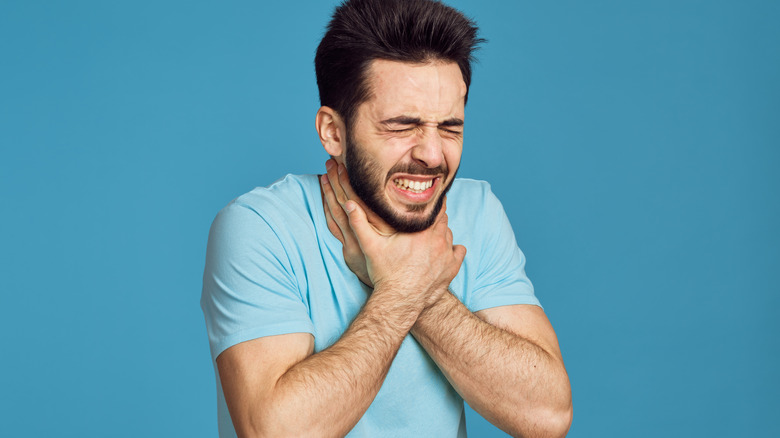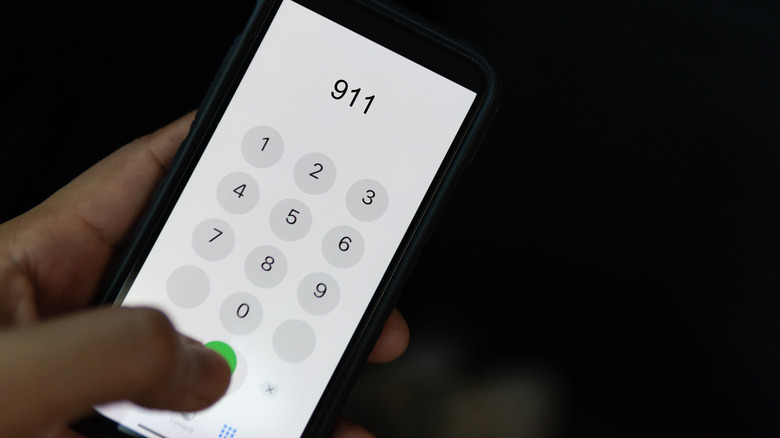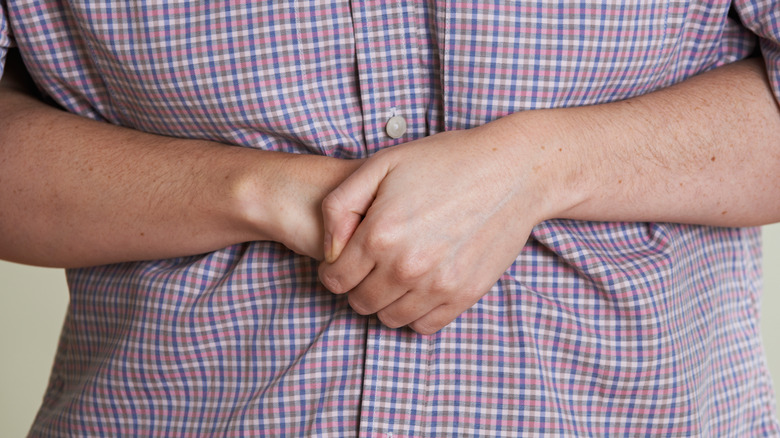The First Thing You Should Do If You Start Choking
If you're home alone and find that you've started to choke on a piece of food, the panic that follows can be terrifying. To prevent the paralysis of panic from taking over, it's important to educate ourselves on what to do — and what not to do — well ahead of time should this ever happen to you. When you're choking, and there is no one around to assist, there are steps you should take to provide your own emergency first aid, so you'll want to know what to do first and foremost.
According to the Mayo Clinic, choking is a bodily response to an object that has become stuck in the windpipe, obstructing the flow of oxygen, and impacting our ability to breathe properly. Telltale signs of choking include difficulty or noisy breathing, the inability to talk, squeaking sounds, coughing, skin or lips turning blue in color, and loss of consciousness. Often, people will signal to others that they are choking by clutching their hands to their throat, indicating a need for help.
Assess your ability to breathe and call for help
Sanford Vieder, medical director of Lakes Urgent Care in West Bloomfield, Michigan, tells Self that it's important to first take note of your level of breathing ability, stating, "If you're able to cough, say any words, or speak in any way, you're not completely occluded." Although it may be an instinctual reaction, Vieder stresses that people who are choking should not drink liquids in an effort to clear their airway, as this can make the problem worse.
Instead, you'll first want to call 911. CPR training experts at ProCPR say you can leave the phone off the hook. Even if you're unable to speak, emergency responders will send help if you remain on the line.
After assessing the state of your breathing and while remaining on the line with 911, your next response should be to try and clear the obstruction by coughing. Vieder states via Self, "The cough reflex is still your best friend to try to expel whatever may be stuck or caught."
How to dislodge the obstruction and what to do after the fact
If you're unable to dislodge the object by coughing, ProCPR advises performing the Self-Heimlich maneuver. Ball up your hand into a fist and place the thumb side in between your belly button and your ribcage. Next, take your other hand and place it on top of your fist. With a hard, quick motion, thrust your hands straight back into your abdomen. CPR experts explain that doing so will place pressure on the bottom of the diaphragm, compress the lungs, and subsequently push air up through your windpipe in an effort to clear the object. To provide additional force, you can also implement this maneuver while leaning over the back of a chair or countertop.
After the fact, it is advised that you seek medical aftercare to check for injury and ensure the airway has been entirely cleared (via Self). To help minimize the risk of choking, it's important to limit distractions while eating, such as driving or texting, and to be mindful of taking small bites and chewing food thoroughly. This is particularly important when consuming alcohol as alcohol can weaken the body's ability to properly route food from the mouth down into the digestive tract.



